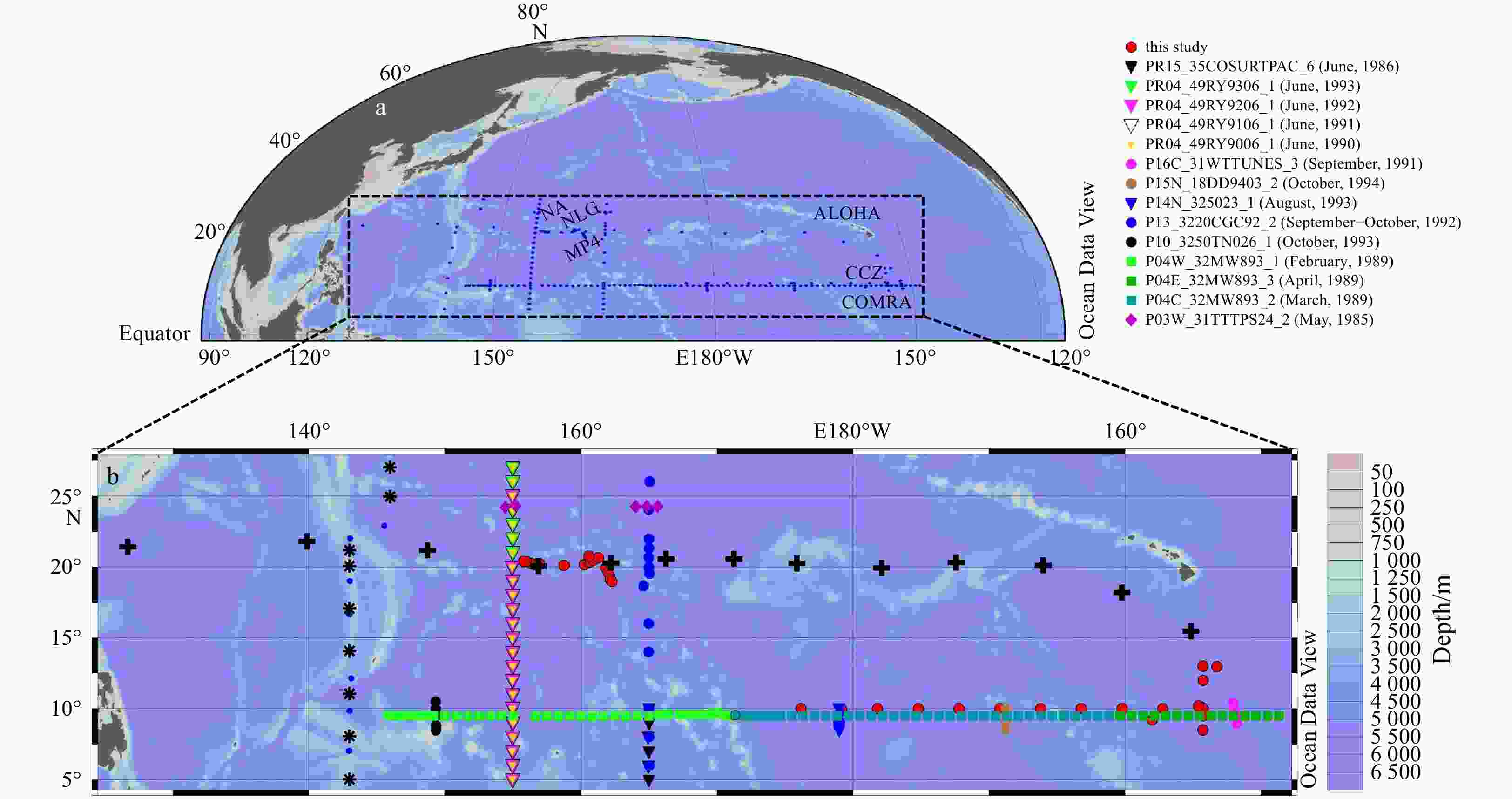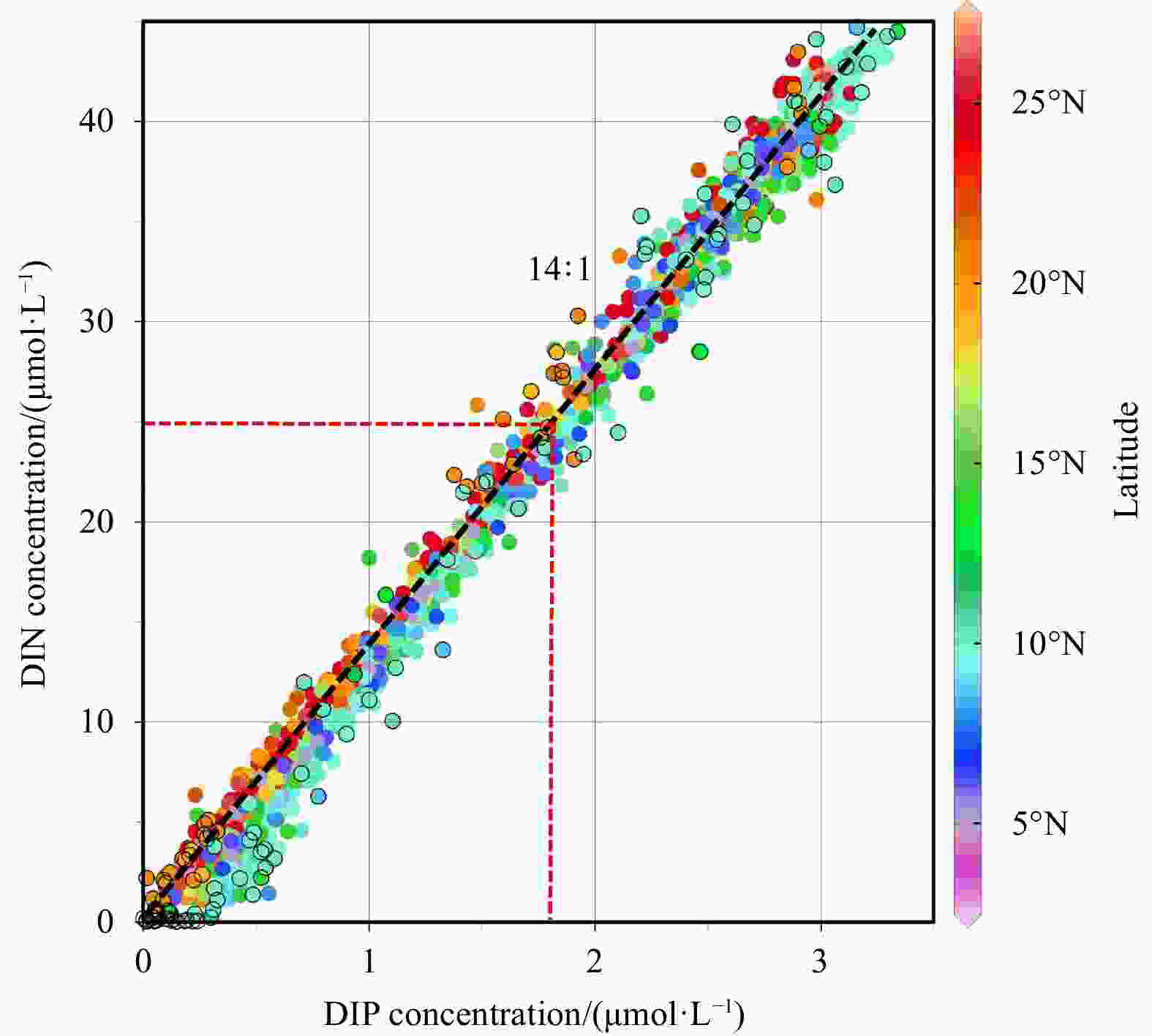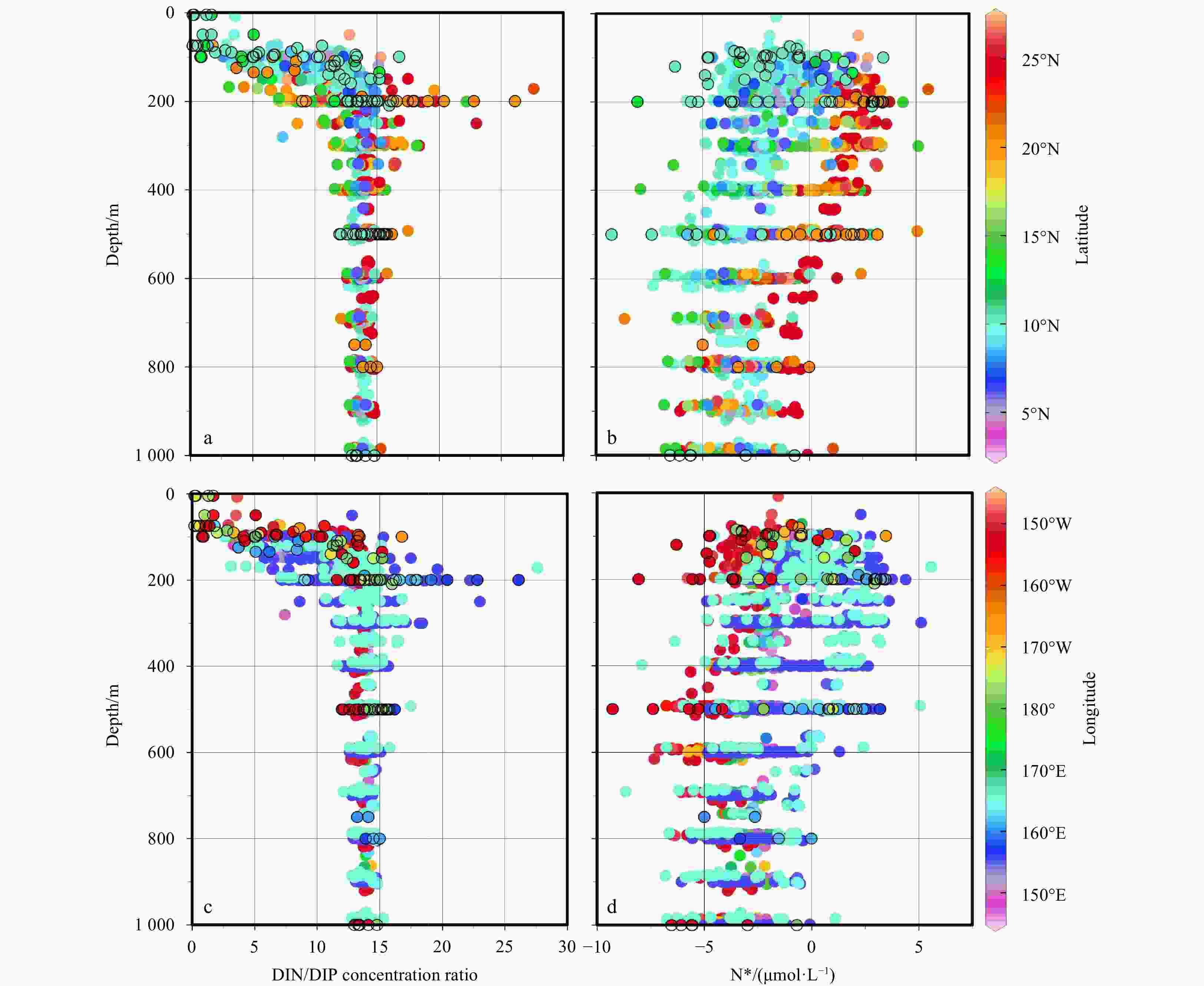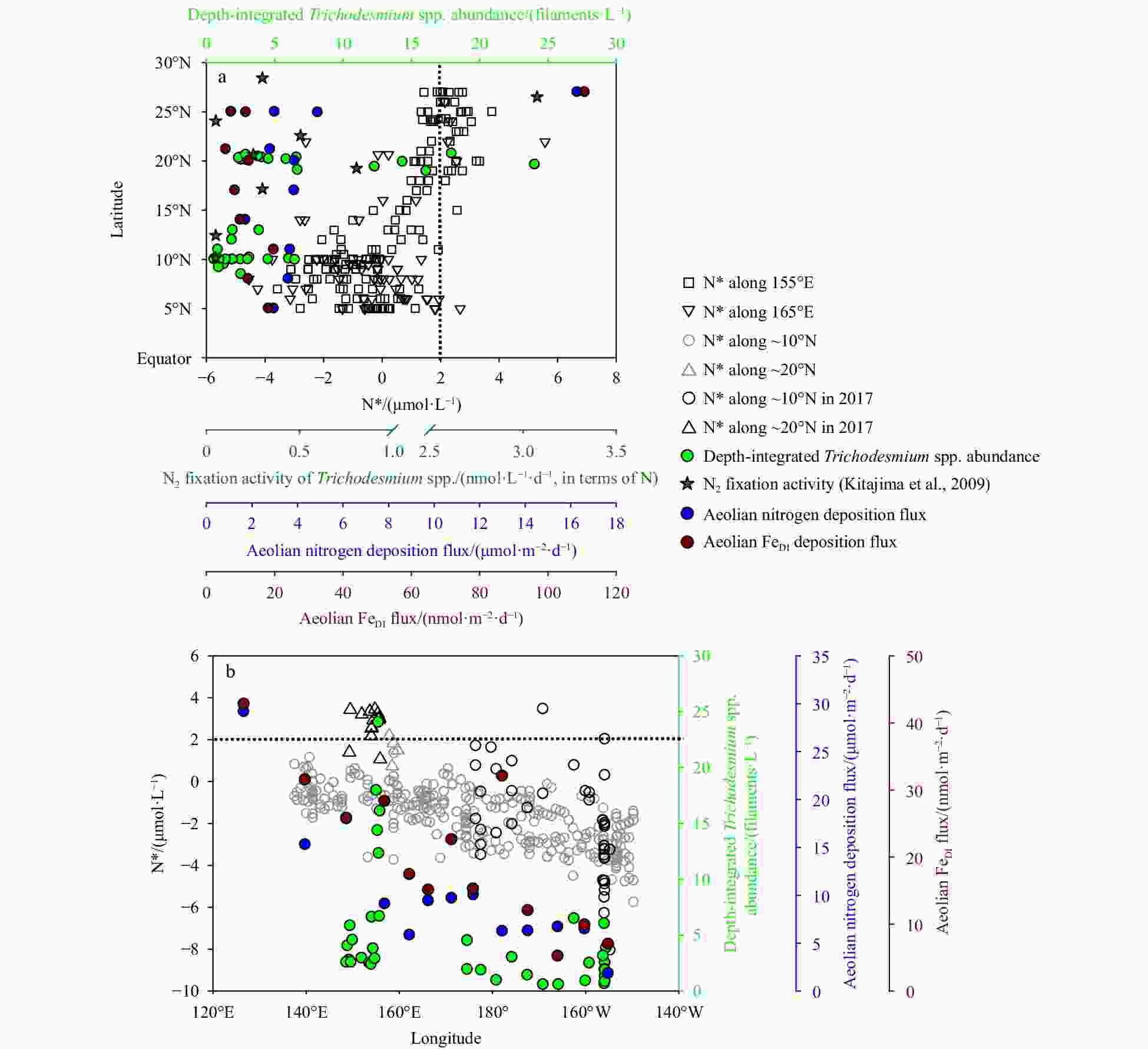Nutrient distributions and nitrogen-anomaly (N*) in the tropical North Pacific Ocean
-
Abstract: Based upon cruise observations broadly covering the tropical North Pacific during July−November 2017, together with data obtained from the World Ocean Circulation Experiment Hydrographic Program, this study examined the distribution of dissolved inorganic nitrogen (DIN, nitrate (
${{\rm {NO}}_3^-} $ )+nitrite (${{\rm {NO}}_2^-} $ )), dissolved inorganic phosphorus (DIP) and related N* (nitrogen-anomaly, N*=N−16P+2.9, where N and P are the concentrations of DIN (>1.0 μmol/L) and DIP (>0.1 μmol/L)), used as an index of N2 fixation, in the upper 1 000 m of the water column. Nutrient concentrations displayed distinct spatial variability in the upper ocean but became relatively constant at a depth of 1 000 m: they were high at low latitudes and in the eastern region, with an obvious nutricline at ~150 m (DIN, ~32.0 μmol/L; DIP, ~2.4 μmol/L) and then generally increased with depth; they decreased markedly (DIN, ~1.2 μmol/L; DIP, ~0.1 μmol/L; at ~150 m) at high latitudes and in the western region, where a nutricline was not apparent. The N* index showed significant meridional and zonal variation, with the most negative values located at low latitudes and in the eastern region (~10°N, ~150°−170°E), while becoming positive towards the northwest (the north of ~18°N, ~160°E westward). A N* concentration larger than 2.0 μmol/L which often used as an indicator of N2 fixation, was observed between 155°E and 165°E; N* values were 2.0 μmol/L to 6.0 μmol/L at ~15°−28°N, i.e., much higher than those in the southern sector (0−2.0 μmol/L at ~5°−10°N). Zonally, N* decreased gradually from west (−2.0 μmol/L to 4.0 μmol/L, ~145°−165°E) to east (−2.0 μmol/L to −8.0 μmol/L, ~155°W) along ~10°N, which was consistent with the distribution of Trichodesmium abundance and N2 fixation rates. Furthermore, since such region was also supplied with aeolian deposition, high N* was probably not only induced by N2 fixation but also influenced by iron and/or nitrogen deposition.-
Key words:
- tropical North Pacific Ocean /
- nutrients /
- nitrogen anomaly /
- nitrogen fixation /
- aeolian deposition
-
Figure 1. Sampling locations in the tropical North Pacific Ocean based on the World Ocean Circulation Experiment (WOCE) program and our in situ cruise conducted from July 12 to November 18, 2017 (a, b). Stations for aerosol sampling conducted from April 8 to May 8, 2017 (black stars) and from July 19 to August 24, 2017 (black plus sign). Field sampling in the in situ cruise 2017 covered 40 stations (red dots with black circles) including a series of seamounts, i.e., Demao and Batiza (NA), Niulang (NLG), and McDonnell (MP4) Guyots, the China mining claim contract area (China Ocean Mineral Resources R&D Association contract area, COMRA) and related deep-sea mining Clarion-Clipperton Zone (CCZ). ALOHA: A Long-term Oligotrophic Habitat Assessment.
Figure 3. Relationship between potential temperature(θ) and salinity in the tropical North Pacific Ocean showing observed water masses with depth indicated by colors, including data from the WOCE program (14 cruises listed in Table 1) and from our in situ cruise during August−November, 2017 (field data indicated by black circles). Isopycnal was indicated by grey lines. NPTSW, North Pacific Tropical Surface Water; NPCW, North Pacific Central Water; CCS-LL, California Current System waters observed at low latitudes (~13°N southward); SPCW-LL, South Pacific Central Water observed at low latitudes (~13°N southward); NPIW, North Pacific Intermediate Water; AAIW, Antarctic Intermediate Water.
Figure 4. Meridional and zonal distributions of dissolved inorganic nitrogen (DIN, a−d) and phosphorus (DIP, e−h) concentrations, respectively, in the upper 1 000 m. Meridional and zonal distributions of nitrite (
${{\rm {NO}}_2^-} $ ) concentrations (i, j) in the upper 200 m along the 10°N and 155°E transects in the tropical North Pacific Ocean. Data were based on both WOCE dataset and our in situ cruise observations in 2017.Figure 5. Relationship between dissolved inorganic nitrogen and phosphorus, DIN and DIP, in the tropical North Pacific Ocean based on the WOCE dataset and in situ cruise data in 2017. Red dashed lines indicate the nutrient discrepancies in latitudinal variation, as DIN concentration ~25.0 μmol/L and DIP concentration ~1.7 μmol/L; 14:1 indicates the slope of the fitted linear regression.
Figure 7. Meridional (along ~155°E and ~165°E) (a) and zonal (along ~10°N and ~20°N) (b) water column depth sections of the nitrogen anomaly (N*, μmol/L) in the upper 200 m of the tropical North Pacific Ocean based on WOCE data and in situ data from the 2017 cruise. Depth-integrated Trichodesmium spp. abundance in the upper 200 m is represented by green dots; N2 fixation activity of Trichodesmium spp. along 155°E measured according to Kitajima et al. (2009) is represented by dark green stars. Latitudinal and longitudinal fluxes of aeolian nitrogen and FeDI deposition were obtained in April−May 2017 and July−August 2017, respectively.
Table 1. Cruise information from the WOCE Hydrographic Program
Cruise Cruise date P03W_31TTTPS24_2 May 10, May 14−15, 1985 P04C_32MW893_2 March 9−21, 1989 P04E_32MW893_3 April 9−15, 1989 P04W_32MW893_1 February 28−March 1, February 23−24,
February 19−March 4, 1989P10_3250TN026_1 October 21−23, 1993 P13_3220CGC92_2 September 30−October 12, October 10, 1992 P14N_325023_1 August 3−4, 1993 P15N_18DD9403_2 October 24−25, 1994 P16C_31WTTUNES_3 September 22−23, 1991 PR04_49RY9006_1 June 20−26, June 24−25, 1990 PR04_49RY9106_1 June 11−18, June 16−17, 1991 PR04_49RY9206_1 June 16, June 19, 1992 PR04_49RY9306_1 June 15−21, June 20, 1993 PR15_35COSURTPAC_6 June 26−27, 1986 -
Baker A R, Adams C, Bell T G, et al. 2013. Estimation of atmospheric nutrient inputs to the Atlantic Ocean from 50°N to 50°S based on large-scale field sampling: iron and other dust-associated elements. Global Biogeochemical Cycles, 27(3): 755–767. doi: 10.1002/gbc.20062 Bhavya P S, Min J O, Kim M S, et al. 2019. A review on marine N2 fixation: mechanism, evolution of methodologies, rates, and future concerns. Ocean Science Journal, 54(4): 515–528. doi: 10.1007/s12601-019-0037-3 Böttjer D, Dore J E, Karl D M, et al. 2016. Temporal variability of nitrogen fixation and particulate nitrogen export at Station ALOHA. Limnology and Oceanography, 62(1): 200–216 Cabrera O C, Villanoy C L, Alabia I D, et al. 2015. Shifts in chlorophyll a off Eastern Luzon, Philippines, associated with the North Equatorial Current bifurcation latitude. Oceanography, 28(4): 46–53. doi: 10.5670/oceanog.2015.80 Capone D G, Burns J A, Montoya J P, et al. 2005. Nitrogen fixation by Trichodesmium spp. : an important source of new nitrogen to the tropical and subtropical North Atlantic Ocean. Global Biogeochemical Cycles, 19(2): GB2024. doi: 10.1029/2004GB002331 Chen Mingming, Lu Yangyang, Jiao Nianzhi, et al. 2019. Biogeographic drivers of diazotrophs in the western Pacific Ocean. Limnology and Oceanography, 64(3): 1403–1421. doi: 10.1002/lno.11123 Chen Ying, Paytan A, Chase Z, et al. 2008. Sources and fluxes of atmospheric trace elements to the Gulf of Aqaba, Red Sea. Journal of Geophysical Research, 113(D5): D05306. doi: 10.1029/2007JD009110 Clark D R, Flynn K J, Owens N J P. 2002. The large capacity for dark nitrate-assimilation in diatoms may overcome nitrate limitation of growth. New Phytologist, 155(1): 101–108. doi: 10.1046/j.1469-8137.2002.00435.x Deutsch C, Gruber N, Key R M, et al. 2001. Denitrification and N2 fixation in the Pacific Ocean. Global Biogeochemical Cycles, 15(2): 483–506. doi: 10.1029/2000GB001291 Gruber N, Sarmiento J L. 1997. Global patterns of marine nitrogen fixation and denitrification. Global Biogeochemical Cycles, 11(2): 235–266. doi: 10.1029/97GB00077 Han Aiqin, Dai Minhan, Kao Shuh-Ji, et al. 2012. Nutrient dynamics and biological consumption in a large continental shelf system under the influence of both a river plume and coastal upwelling. Limnology and Oceanography, 57(2): 486–502. doi: 10.4319/lo.2012.57.2.0486 Harrison P J, Boyd P W, Varela D E, et al. 1999. Comparison of factors controlling phytoplankton productivity in the NE and NW subarctic Pacific gyres. Progress in Oceanography, 43(2–4): 205–234 Hu Dunxin, Wu Lixin, Cai Wenju, et al. 2015. Pacific western boundary currents and their roles in climate. Nature, 522(7556): 299–308. doi: 10.1038/nature14504 Hung J J, Wang S M, Chen Y L. 2007. Biogeochemical controls on distributions and fluxes of dissolved and particulate organic carbon in the northern South China Sea. Deep-Sea Research Part II: Topical Studies in Oceanography, 54(14–15): 1486–1503, Hynes A M, Webb E A, Doney S C, et al. 2012. Comparison of cultured Trichodesmium (Cyanophyceae) with species characterized from the field. Journal of Phycology, 48(1): 196–210. doi: 10.1111/j.1529-8817.2011.01096.x Karl D, Michaels A, Bergman B, et al. 2002. Dinitrogen fixation in the world’s oceans. Biogeochemistry, 57(1): 47–98. doi: 10.1023/A:1015798105851 Kim T H, Kim G. 2013. Changes in seawater N: P ratios in the northwestern Pacific Ocean in response to increasing atmospheric N deposition: results from the East (Japan) Sea. Limnology and Oceanography, 58(6): 1907–1914. doi: 10.4319/lo.2013.58.6.1907 Kim I N, Lee K, Gruber N, et al. 2014. Increasing anthropogenic nitrogen in the North Pacific Ocean. Science, 346(6213): 1102–1106. doi: 10.1126/science.1258396 Kim T W, Lee K, Najjar R G, et al. 2011. Increasing N abundance in the northwestern Pacific Ocean due to atmospheric nitrogen deposition. Science, 334(6055): 505–509. doi: 10.1126/science.1206583 Kitajima S, Furuya K, Hashihama F, et al. 2009. Latitudinal distribution of diazotrophs and their nitrogen fixation in the tropical and subtropical western North Pacific. Limnology and Oceanography, 54(2): 537–547. doi: 10.4319/lo.2009.54.2.0537 Liu Zhiyu, Lian Qiang, Zhang Fangtao, et al. 2017. Weak thermocline mixing in the North Pacific low-latitude western boundary current system. Geophysical Research Letters, 44(20): 10530–10539. doi: 10.1002/2017GL075210 Luo Yawei, Doney S C, Anderson L A, et al. 2012. Database of diazotrophs in global ocean: abundance, biomass and nitrogen fixation rates. Earth System Science Data, 4(1): 47–73. doi: 10.5194/essd-4-47-2012 Luo Li, Yao Xiaohong, Gao Huiwang, et al. 2016. Nitrogen speciation in various types of aerosols in spring over the northwestern Pacific Ocean. Atmospheric Chemistry and Physics, 16(1): 325–341. doi: 10.5194/acp-16-325-2016 Ma Jun, Song Jinming, Li Xuegang, et al. 2019. Environmental characteristics in three seamount areas of the tropical western Pacific Ocean: focusing on nutrients. Marine Pollution Bulletin, 143: 163–174. doi: 10.1016/j.marpolbul.2019.04.045 Matsumoto K, Abe O, Fujiki T, et al. 2016. Primary productivity at the time-series stations in the northwestern Pacific Ocean: is the subtropical station unproductive?. Journal of Oceanography, 72(3): 359–371. doi: 10.1007/s10872-016-0354-4 Okin G S, Baker A R, Tegen I, et al. 2011. Impacts of atmospheric nutrient deposition on marine productivity: roles of nitrogen, phosphorus, and iron. Global Biogeochemical Cycles, 25(2): GB2022. doi: 10.1029/2010GB003858 Piazzalunga A, Bernardoni V, Fermo P, et al. 2013. Optimisation of analytical procedures for the quantification of ionic and carbonaceous fractions in the atmospheric aerosol and applications to ambient samples. Analytical and Bioanalytical Chemistry, 405(2): 1123–1132 Pickard G L, Emery W J. 1990. Descriptive Physical Oceanography: An Introduction. 5th ed. Oxford: Pergamon Press Qiu Bo, Rudnick D L, Cerovecki I, et al. 2015. The Pacific north equatorial current: new insights from the origins of the Kuroshio and Mindanao Currents (OKMC) Project. Oceanography, 28(4): 24–33. doi: 10.5670/oceanog.2015.78 Redfield A C, Ketchum B H, Richards F A. 1963. The influence of organisms on the composition of sea-water. In: Hill M N, ed. The Sea. New York: Interscience, 26–77 Schlitzer R. 2004. Export production in the equatorial and North Pacific derived from dissolved oxygen, nutrient and carbon data. Journal of Oceanography, 60(1): 53–62. doi: 10.1023/B:JOCE.0000038318.38916.e6 Shi Jinhui, Wang Nan, Gao Huiwang, et al. 2019. Phosphorus solubility in aerosol particles related to particle sources and atmospheric acidification in Asian continental outflow. Atmospheric Chemistry and Physics, 19(2): 847–860. doi: 10.5194/acp-19-847-2019 Shiozaki T, Furuya K, Kodama T, et al. 2009. Contribution of N2 fixation to new production in the western North Pacific Ocean along 155°E. Marine Ecology Progress Series, 377: 19–32. doi: 10.3354/meps07837 Singh A, Bach L T, Fischer T, et al. 2017. Niche construction by non-diazotrophs for N2 fixers in the eastern tropical North Atlantic Ocean. Geophysical Research Letters, 44(13): 6904–6913. doi: 10.1002/2017GL074218 Strickland J D H, Parsons T R. 1972. A Practical Handbook of Seawater Analysis. 2nd ed. Ottawa: Fisheries Research Board of Canada Sverdrup H U, Fleming R H, Johnson M W. 1942. The Oceans, Their Physics, Chemistry, and General Biology. New York: Prentice-Hall Tsuchiya M. 1968. Upper Waters of the Intertropical Pacific Ocean. Baltimore: Johns Hopkins Press, 1–50 Wong G T F, Tseng C M, Wen Liang-Saw, et al. 2007. Nutrient dynamics and N-anomaly at the SEATS station. Deep-Sea Research Part II: Topical Studies in Oceanography, 54(14–15): 1528–1545 Zhang Lei, Tian Yongqing, Pan Aijun, et al. 2019a. Analysis of water masses at the 10°N section in the tropical central and eastern Pacific. Haiyang Xuebao (in Chinese), 41(11): 40–50 Zhang Run, Zhang Dongsheng, Chen Min, et al. 2019b. N2 fixation rate and diazotroph community structure in the western tropical North Pacific Ocean. Acta Oceanologica Sinica, 38(12): 26–34. doi: 10.1007/s13131-019-1513-4 Zhu Yifan, Liu Jing, Huang Tao, et al. 2018. On the fluorometric measurement of ammonium in oligotrophic seawater: assessment of reagent blanks and interferences. Limnology and Oceanography, 16(8): 516–524 -







 下载:
下载:










